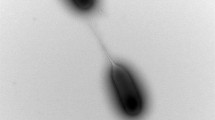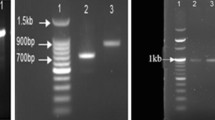Abstract
The Y-12 plant in Oak Ridge, TN, which manufactured nuclear weapons during World War II and the Cold War, contaminated East Fork Poplar Creek with heavy metals. The multimetal resistant bacterial strain, Stenotrophomonas maltophilia Oak Ridge strain O2 (S. maltophilia O2), was isolated from East Fork Poplar Creek. Sequence analysis of 16s rDNA suggested that our working strain of S. maltophilia O2 was a strain of Enterobacter. Phylogenetic tree analysis and biochemical tests confirmed that it belonged to an Enterobacter species. This new strain was named Enterobacter sp. YSU. Using a modified R3A growth medium, R3A-Tris, the Hg(II), Cd(II), Zn(II), Cu(II), Au(III), Cr(VI), Ag(I), As(III), and Se(IV) MICs for a confirmed strain of S. maltophilia O2 were 0.24, 0.33, 5, 5, 0.25, 7, 0.03, 14, and 40 mM, respectively, compared to 0.07, 0.24, 0.8, 3, 0.05, 0.4, 0.08, 14, and 40 mM, respectively, for Enterobacter sp. YSU. Although S. maltophilia O2 was generally more metal resistant than Enterobacter sp. YSU, in comparison to Escherichia coli strain HB101, Enterobacter sp. YSU was resistant to Hg(II), Cd(II), Zn(II), Au(III), Ag(I), As(III), and Se(IV). By studying metal resistances in these two strains, it may be possible to understand what makes one microorganism more metal resistant than another microorganism. This work also provided benchmark MICs that can be used to evaluate the metal resistance properties of other bacterial isolates from East Fork Poplar Creek and other metal contaminated sites.

Similar content being viewed by others
References
Altschul SF, Madden TL, Schaffer AA et al (1997) Gapped BLAST and PSI-BLAST: a new generation of protein database search programs. Nucleic Acids Res 25:3389–3402
Ausubel F, Brent R, Kingston RE et al (1997) Short protocols in molecular biology, 3rd edn. Wiley, New York
Barreiros L, Nogales B, Manaia CM et al (2003) A novel pathway for mineralization of the thiocarbamate herbicide molinate by a defined bacterial mixed culture. Environ Microbiol 5:944–953
Brooks SC (2001) Waste characteristics of the former S-3 ponds and outline of uranium chemistry relevant to NABIR field research center studies. ORNLITM-2001/27 http://www.osti.gov/energycitations/servlets/purl/814525-OXnnBu/native/
Chung H, Park M, Madhaiyan M et al (2005) Isolation and characterization of phosphate solubilizing bacteria from the rhizosphere of crop plants of Korea. Soil Biol Biochem 37:1970–1974
Crossman LC, Gould VC, Dow JM et al (2008) The complete genome, comparative and functional analysis of Stenotrophomonas maltophilia reveals an organism heavily shielded by drug resistance determinants. Genome Biol 9:R74
Davis IJ, Richards H, Mullany P (2005) Isolation of silver- and antibiotic-resistant Enterobacter cloacae from teeth. Oral Microbiol Immunol 20:191–194
Denton M, Kerr KG (1998) Microbiological and clinical aspects of infection associated with Stenotrophomonas maltophilia. Clin Microbiol Rev 11:57–80
Efron B, Halloran E, Holmes S (1996) Bootstrap confidence levels for phylogenetic trees. Proc Natl Acad Sci USA 93:13429–13434
Farmer JJIII, Davis BR, Hickman-Brenner FW et al (1985) Biochemical identification of new species and biogroups of Enterobacteriaceae isolated from clinical specimens. J Clin Microbiol 21:46–76
Gould VC, Okazaki A, Avison MB (2006) Beta-lactam resistance and beta-lactamase expression in clinical Stenotrophomonas maltophilia isolates having defined phylogenetic relationships. J Antimicrob Chemother 57:199–203
Grimont F, Grimont P (2006) The genus Enterobacter. In: Dworkin M, Falkow S, Rosenberg E, Schleifer K-H, Stackebrandt E (eds) The prokaryotes: volume 6: proteobacteria: gamma Subclass. Springer, New York, pp 197–214
Haferburg G, Kothe E (2007) Microbes and metals: interactions in the environment. J Basic Microbiol 47:453–467
Harley JP (2008) Laboratory exercises in microbiology, 7th edn. McGraw-Hill/Higher Education, Boston
Hu Q, Dou MN, Qi HY et al (2007) Detection, isolation, and identification of cadmium-resistant bacteria based on PCR-DGGE. J Environ Sci (China) 19:1114–1119
Laramee L, Lawrence JR, Greer CW (2000) Molecular analysis and development of 16S rRNA oligonucleotide probes to characterize a diclofop-methyl-degrading biofilm consortium. Can J Microbiol 46:133–142
Lima-Bittencourt CI, Cursino L, Goncalves-Dornelas H et al (2007) Multiple antimicrobial resistance in Enterobacteriaceae isolates from pristine freshwater. Genet Mol Res 6:510–521
Minkwitz A, Berg G (2001) Comparison of antifungal activities and 16S ribosomal DNA sequences of clinical and environmental isolates of Stenotrophomonas maltophilia. J Clin Microbio 39:139–145
Pages D, Rose J, Conrod S et al (2008) Heavy metal tolerance in Stenotrophomonas maltophilia. PLoS ONE 3:e1539
Reasoner DJ, Geldreich EE (1985) A new medium for the enumeration and subculture of bacteria from potable water. Appl Environ Microbiol 49:1–7
Revis NW, Benson SB, Osborne TR (1989) Reduction of trace elements to the elemental form by microorganisms. US patent 4826602
Rouse Campbell K, Ford CJ, and Levine DA (1998) Mercury distribution in Poplar Creek, Oak Ridge, Tennessee, USA. Environ Toxicol Chem 17:1191–1198
Saitou N, Nei M (1987) The neighbor-joining method: a new method for reconstructing phylogenetic trees. Mol Biol Evol 4:406–425
Summers AO (2006) Genetic linkage and horizontal gene transfer, the roots of the antibiotic multi-resistance problem. Anim Biotechnol 17:125–135
Tamura K, Nei M, Kumar S (2004) Prospects for inferring very large phylogenies by using the neighbor-joining method. Proc Natl Acad Sci USA 101:11030–11035
Tamura K, Dudley J, Nei M et al (2007) MEGA4: molecular evolutionary genetics analysis (MEGA) software version 4.0. Mol Biol Evol 24:1596–1599
Thompson JD, Higgins DG, Gibson TJ (1994) CLUSTAL W: improving the sensitivity of progressive multiple sequence alignment through sequence weighting, position-specific gap penalties and weight matrix choice. Nucleic Acids Res 22:4673–4680
Wang PC, Mori T, Komori K et al (1989) Isolation and characterization of an Enterobacter cloacae strain that reduces hexavalent chromium under anaerobic conditions. Appl Environ Microbiol 55:1665–1669
Widner TE, Ripple SR, Buddenbaum JE (1996) Identification and screening evaluation of key historical materials and emission sources at the Oak Ridge Reservation. Health Phys 71:457–469
Wildschutte H, Lawrence JG (2007) Differential Salmonella survival against communities of intestinal amoebae. Microbiology 153:1781–1789
Acknowledgments
This study was funded by the National Science Foundation through Grant numbers 0542178 and 0620240 and the University Research Council at the Youngstown State University (YSU) School of Graduate Studies. We thank Julio “Ed” Budde from the Department of Biological Sciences at YSU for resolving our sequencing reactions, Thomas Schmidt from Michigan State University (MSU) and Xiang Jia Min from YSU for help with 16s rDNA sequencing and analysis, Jay Kerns from the Department of Mathematics and Statistics at YSU for help with calculating the standard MIC errors and Anne Summers from the University of Georgia, Julius Jackson from Michigan State University, Xiang Jia Min and Chester Cooper, Jr from YSU for critiquing the manuscript.
Author information
Authors and Affiliations
Corresponding author
Electronic supplementary material
Below is the link to the electronic supplementary material.
Rights and permissions
About this article
Cite this article
Holmes, A., Vinayak, A., Benton, C. et al. Comparison of Two Multimetal Resistant Bacterial Strains: Enterobacter sp. YSU and Stenotrophomonas maltophilia ORO2. Curr Microbiol 59, 526–531 (2009). https://doi.org/10.1007/s00284-009-9471-2
Received:
Revised:
Accepted:
Published:
Issue Date:
DOI: https://doi.org/10.1007/s00284-009-9471-2




